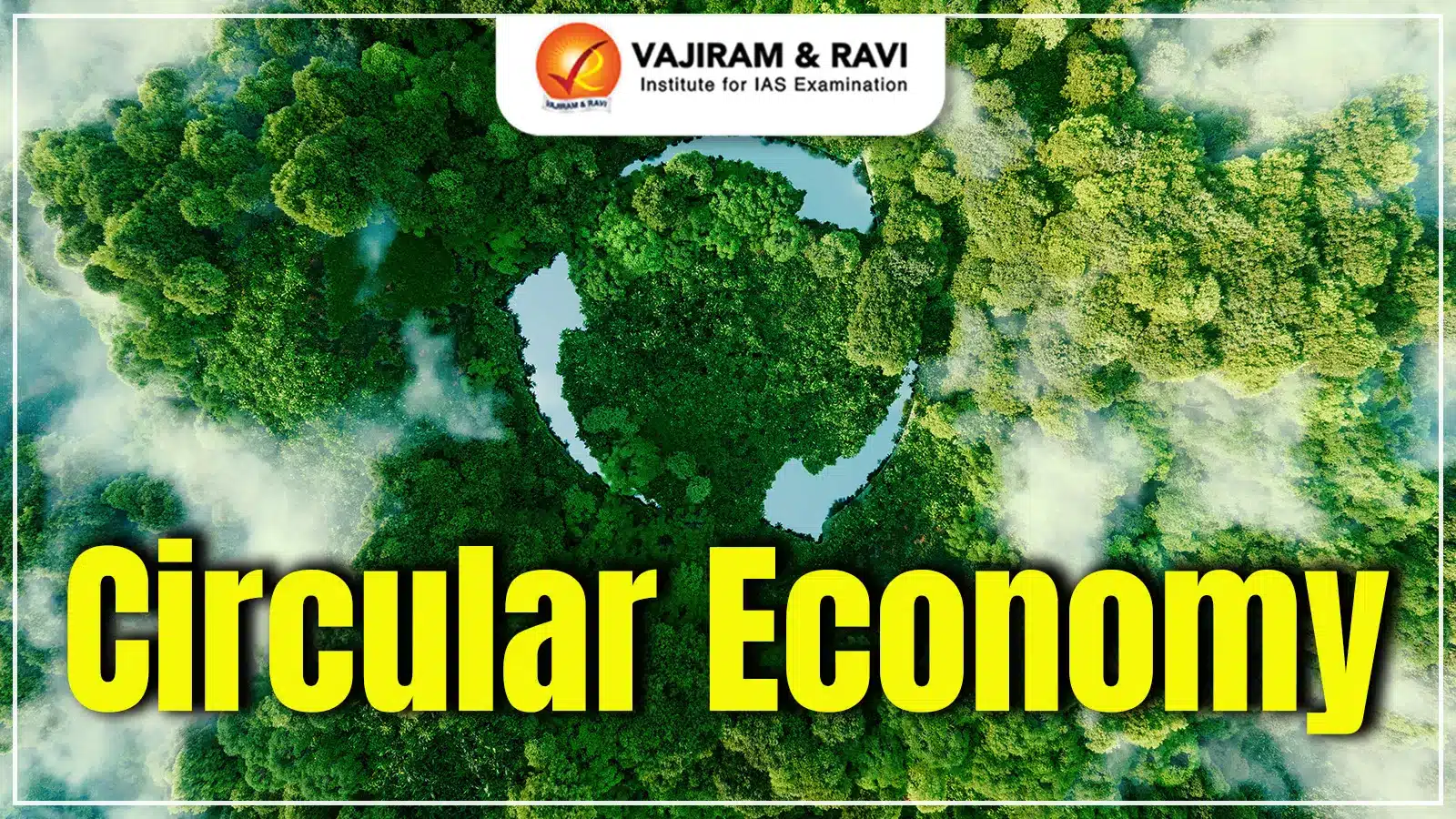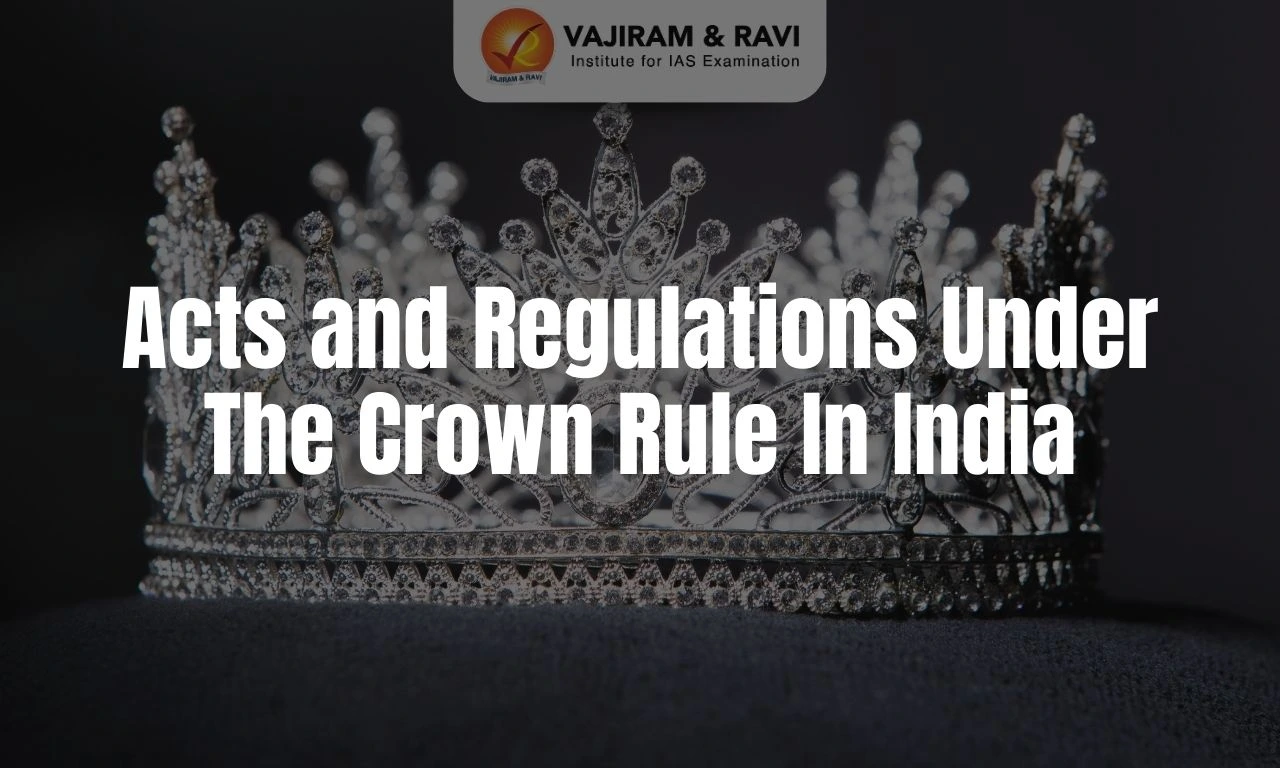Circular economy represents a transformative shift from traditional linear production models, prioritising resource efficiency, waste elimination, and ecological regeneration. Unlike the linear model, which relies heavily on finite natural resources and generates massive waste, the circular economy keeps products, components, and materials in circulation for as long as possible.
The idea of the circular economy is gaining traction globally, including in India, as governments, businesses, and communities realise the need for sustainable practices. The circular economy supports the achievement of Sustainable Development Goals (SDGs), particularly in responsible consumption and production, climate action, and sustainable cities.
Circular Economy Meaning
A circular economy is an economic system designed to eliminate waste and pollution by keeping products and materials in continuous use through maintenance, reuse, refurbishment, and recycling. Unlike the linear “take-make-waste” model, it emphasises closing material loops, reducing resource extraction, and regenerating natural ecosystems.
- The circular economy is a key pillar within broader frameworks such as Sustainable Development, and is strongly aligned with SDG Goals, including responsible consumption, climate action, and sustainable industry.
- The circular economy addresses climate change and major global issues such as biodiversity loss, waste generation, and pollution by breaking the link between economic growth and the use of limited natural resources.
- Core principles of circular economy include:
- Eliminating waste through smarter design and production.
- Extending product lifespans via repair, remanufacturing, and sharing.
- Regenerating ecosystems by transitioning to renewable energy and restoring biodiversity.
- This model decouples economic growth from resource depletion, addressing climate change, biodiversity loss, and pollution. For example, IKEA’s furniture buy-back program keeps products in use longer, reducing landfill waste.
- Circular economy is closely related to the Green Economy as both aim to achieve sustainability by minimising waste, conserving resources, and promoting environmentally responsible growth.
- It also connects with the Blue Economy, which focuses on the sustainable use of ocean resources and waste reduction in marine ecosystems.
- Unlike the linear economy, which mainly focuses on gross domestic product (GDP) and often leads to environmental degradation and resource depletion, the circular economy emphasises sustainability and resilience.
- In the context of the Sectors of Indian Economy, the circular model impacts manufacturing, agriculture, and services by promoting sustainable production and consumption across sectors.
- Moreover, with India increasingly adopting Digital Economy tools like blockchain technology and Artificial Intelligence, circular processes such as traceability, e-waste tracking, and smart logistics are becoming more efficient and scalable.
Circular Economy Example
A practical example of a circular economy is the electronics industry’s approach to smartphone production. Companies now focus on designing devices for easy disassembly, enabling the recovery of valuable materials like metals and rare earth elements. Used phones are refurbished or recycled to extract components, reducing e-waste and conserving resources. This closed-loop system not only minimises environmental impact but also lowers production costs and supports sustainable consumption patterns.
Seven Pillars of the Circular Economy
The Seven Pillars of the Circular Economy guide sustainable practices by emphasising high-value material use, biodiversity protection, cultural preservation, human health, fair resource use, and efficient water management to create a balanced, resilient system.
- Materials are Cycled at Continuous High Value: Materials are reused at their highest value for as long as possible, with minimal mixing, short transport distances, and a focus on reducing use and conserving complexity to suit natural and human cycles.
- Protection of Biodiversity: The circular economy prioritises protecting biodiversity by avoiding damage to natural habitats, even if it means accepting some resource loss, as preserving ecological diversity strengthens the resilience of the biosphere.
- Sustainable Water Use: Water is conserved and reused efficiently, with technologies reducing freshwater use, recovering nutrients from wastewater, and protecting ecosystems from pollution and harmful emissions.
- Preservation of Human Society and Culture: The circular economy values human culture and social unity, using fair governance to meet stakeholder needs while avoiding actions that harm cultural well-being, even if it comes at a high cost.
- Human Health and Well-being Are Prioritised: Human and environmental health are protected. Harmful substances are strictly controlled or eliminated, and unsafe practices like burning e-waste are not considered truly circular.
- Fair Use of Limited Resources: Human activities should use limited resources to create maximum societal value—financial, emotional, ecological, or aesthetic—rather than focusing only on profits, as all value types matter in their own right.
Circular Economy Benefits
The circular economy offers wide-ranging benefits by reducing waste, conserving resources, cutting emissions, creating jobs, and improving community well-being—making it a sustainable model for long-term environmental, economic, and social growth.
- Environmental Benefits
- Conservation of Resources: By designing products for longevity and reuse, circular systems can reduce raw material extraction by up to 32% by 2030.
- Carbon Footprint Reduction: Adopting circular strategies, such as recycling and remanufacturing, could cut global greenhouse gas emissions by nearly 39% by 2050.
- Waste Reduction: Shifting from a ‘take-make-dispose’ model to a circular one drastically cuts waste generation. Circular systems prioritise recycling, composting, and remanufacturing, helping divert substantial waste from landfills and oceans.
- Economic Benefits
- Operational Savings: Businesses implementing circular practices, like remanufacturing, can lower production costs by 10-15%.
- Employment Growth: The International Labour Organisation estimates that the global shift to a circular economy could generate 6-7 million new jobs globally by 2030.
- Business Model Innovation: Circular business models such as leasing and sharing platforms are projected to create $4.5 trillion in additional economic output by 2030.
- Social Benefits
- Broader Consumer Access: Circular markets offer affordable refurbished or shared products, making quality goods accessible to a wider population and reducing household spending.
- Healthier Environments: Communities benefit from cleaner air and water, as circular initiatives reduce incineration and landfill-related pollution, lowering health risks.
Roadblocks to Achieving Circular Economy
Several challenges hinder the transition to a circular economy, including a lack of awareness, insufficient infrastructure, high upfront costs, regulatory gaps, and resistance to changing traditional business and consumer habits.
- Regulatory: Fragmented and outdated regulations, including customs and international agreements, hinder the standardisation needed for circular economy practices.
- Technological: Technological barriers such as limited recycling innovation, poor data traceability, and conflicts between product functionality and circularity slow progress.
- Infrastructure: Inadequate infrastructure, including weak reverse logistics, insufficient collection and sorting systems, and scalability issues, restricts effective material recovery.
- Financial: Financial obstacles like higher costs for circular materials, significant upfront investments, and unsuitable accounting methods discourage adoption.
- Organisational: Organisational and social challenges—ranging from internal resistance, supply chain complexity, and unclear progress metrics to consumer habits, lack of return information, and material contamination—impede widespread implementation.
Circular Economy Way Forward
The way forward for a circular economy lies in integrating robust policies, advanced technologies, and strong industry-government collaboration. This approach fosters sustainable resource use, minimises waste, and promotes economic growth through innovative recycling and reuse practices.
- Statutory Reforms: Overcoming challenges requires legislative mandates for using recycled materials early in production and creating unified laws that regulate circular economy practices effectively across industries.
- Circular Economy Framework: A clear, simplified reporting system for circular economy activities, including EPR certificate trading and fiscal incentives, will support businesses in completing sustainable supply chains efficiently.
- Syncing Laws with Implementation: Government efforts must align with actionable strategies and industry partnerships to encourage businesses to confidently adopt circular economy models and maximise environmental and economic benefits.
- R&D Investments: The renewable energy sector should prioritise research into innovative recycling technologies, increasing efficiency while minimising environmental impact, alongside partnerships with global firms for domestic recycling development.
- Technology-Driven Recycling: Promoting recycling-focused R&D in educational institutions and establishing urban composting centres can engage communities, improve waste management technology, and enhance soil health without chemical fertilisers.
Circular Economy UPSC PYQs
Q1. Consider the following statements: (UPSC Prelims 2025)
Statement I: Circular economy reduces the emissions of greenhouse gases.
Statement II: Circular economy reduces the use of raw materials as inputs.
Statement III: Circular economy reduces wastage in the production process.
Which one of the following is correct in respect of the above statements?
(a) Both Statement II and Statement III are correct and both of them explain Statement I
(b) Both Statement II and Statement III are correct but only one of them explains Statement I
(c) Only one of the Statements II and III is correct and that explains Statement I
(d) Neither Statement II nor Statement III is correct
Ans: (a)
Last updated on December, 2025
→ Check out the latest UPSC Syllabus 2026 here.
→ Join Vajiram & Ravi’s Interview Guidance Programme for expert help to crack your final UPSC stage.
→ UPSC Mains Result 2025 is now out.
→ UPSC Notification 2026 is scheduled to be released on January 14, 2026.
→ UPSC Calendar 2026 is released on 15th May, 2025.
→ The UPSC Vacancy 2025 were released 1129, out of which 979 were for UPSC CSE and remaining 150 are for UPSC IFoS.
→ UPSC Prelims 2026 will be conducted on 24th May, 2026 & UPSC Mains 2026 will be conducted on 21st August 2026.
→ The UPSC Selection Process is of 3 stages-Prelims, Mains and Interview.
→ UPSC Result 2024 is released with latest UPSC Marksheet 2024. Check Now!
→ UPSC Prelims Result 2025 is out now for the CSE held on 25 May 2025.
→ UPSC Toppers List 2024 is released now. Shakti Dubey is UPSC AIR 1 2024 Topper.
→ UPSC Prelims Question Paper 2025 and Unofficial Prelims Answer Key 2025 are available now.
→ UPSC Mains Question Paper 2025 is out for Essay, GS 1, 2, 3 & GS 4.
→ UPSC Mains Indian Language Question Paper 2025 is now out.
→ UPSC Mains Optional Question Paper 2025 is now out.
→ Also check Best IAS Coaching in Delhi
Circular Economy FAQs
Q1. What is the circular economy concept?+
Q2. What are the 7 pillars of the circular economy?+
Q3. What are the 4 R's of circular economy?+
Q4. What are the 5 R's of circular economy?+
Q5. What is an example of circular economy?+

















